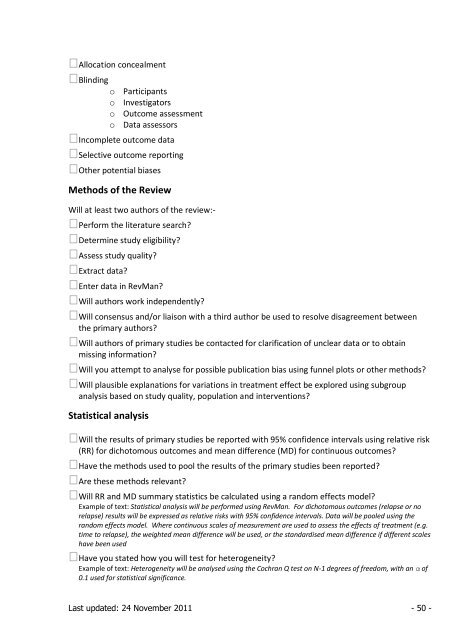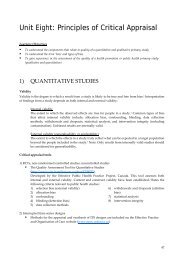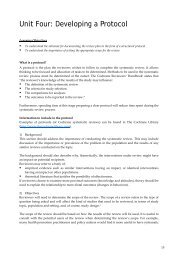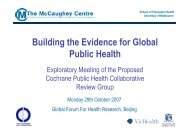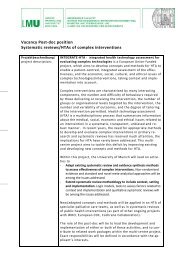Guide for Developing a Cochrane Protocol - Cochrane Public Health ...
Guide for Developing a Cochrane Protocol - Cochrane Public Health ...
Guide for Developing a Cochrane Protocol - Cochrane Public Health ...
Create successful ePaper yourself
Turn your PDF publications into a flip-book with our unique Google optimized e-Paper software.
Allocation concealment<br />
Blinding<br />
o Participants<br />
o Investigators<br />
o Outcome assessment<br />
o Data assessors<br />
Incomplete outcome data<br />
Selective outcome reporting<br />
Other potential biases<br />
Methods of the Review<br />
Will at least two authors of the review:-<br />
Per<strong>for</strong>m the literature search?<br />
Determine study eligibility?<br />
Assess study quality?<br />
Extract data?<br />
Enter data in RevMan?<br />
Will authors work independently?<br />
Will consensus and/or liaison with a third author be used to resolve disagreement between<br />
the primary authors?<br />
Will authors of primary studies be contacted <strong>for</strong> clarification of unclear data or to obtain<br />
missing in<strong>for</strong>mation?<br />
Will you attempt to analyse <strong>for</strong> possible publication bias using funnel plots or other methods?<br />
Will plausible explanations <strong>for</strong> variations in treatment effect be explored using subgroup<br />
analysis based on study quality, population and interventions?<br />
Statistical analysis<br />
Will the results of primary studies be reported with 95% confidence intervals using relative risk<br />
(RR) <strong>for</strong> dichotomous outcomes and mean difference (MD) <strong>for</strong> continuous outcomes?<br />
Have the methods used to pool the results of the primary studies been reported?<br />
Are these methods relevant?<br />
Will RR and MD summary statistics be calculated using a random effects model?<br />
Example of text: Statistical analysis will be per<strong>for</strong>med using RevMan. For dichotomous outcomes (relapse or no<br />
relapse) results will be expressed as relative risks with 95% confidence intervals. Data will be pooled using the<br />
random effects model. Where continuous scales of measurement are used to assess the effects of treatment (e.g.<br />
time to relapse), the weighted mean difference will be used, or the standardised mean difference if different scales<br />
have been used<br />
Have you stated how you will test <strong>for</strong> heterogeneity?<br />
Example of text: Heterogeneity will be analysed using the Cochran Q test on N-1 degrees of freedom, with an α of<br />
0.1 used <strong>for</strong> statistical significance.<br />
Last updated: 24 November 2011 - 50 -


